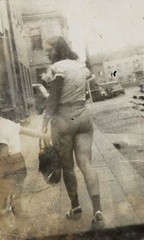Model on Roberto Cavalli poster. Taken not far from Bodega Sochaux in Antwerp on 09/04/2008 at 18:51:58.
There is a “hole” in the model’s head due to the billboard reflection.

Model on Roberto Cavalli poster. Taken not far from Bodega Sochaux in Antwerp on 09/04/2008 at 18:51:58.
There is a “hole” in the model’s head due to the billboard reflection.
Tokyo Nobody (2000) – Masataka Nakano
Masataka Nakano is a Japanese photographer, best-known for his Tokyo Nobody anthology, a series of photos of Tokyo, devoid of its 10 to 15 million inhabitants; mostly shot on the New Year holiday when all city dwellers go to visit relatives out in the country and Tokyo becomes a ghost town.
Via Trevor Brown (1).
See also: abandonment

Baby Got Back (a.k.a. “I Like Big Butts“)
Via gmtPlus9 (-15) comes outsider artist par excellence Miroslav Tichý, a Czech photographer and painter. During many years Tichý wandered the small Moravian town of Kyjov in rags, pursuing his obsession with the female form by secretly photographing women in the streets, shops and parks with cameras he made from tin cans, children’s spectacle lenses and other junk he found on the street. He would return home each day to make prints on equally primitive equipment, making only one print from the negatives he selected. His work remained largely unknown until 2005, when he was 79 years old.
From Leni Riefensthal’s book
I have a habit of running into ontological problems, so my third entry in the “cult fiction” series [1] is appropriately not really fiction. It’s documentary photography, a problematic genre that is neither fact nor fiction. The Last of the Nuba belongs to the realm of documentary, faction, pseudo-documentary and pamphlet.
Leni Riefenstahl, better known for directing Triumph of the Will and Olympia, published a collection of her photographs of the people titled The Last of the Nuba in 1974. The book was extensively reviewed in Fascinating Fascism by Susan Sontag.
Fascinating Fascism is quite an essay. It was first published in 1975 and republished in Under the Sign of Saturn, in 1980. The essay considers the link between fascist aesthetics to sadomasochism.
I started reading the essay last evening, and haven’t finished yet, but time and time again, Susan Sontag strikes me as one of the most insightful cultural critics of the 20th century, way up there with Walter Benjamin.
The essay is of an era that also saw Salò by Pasolini and The Night Porter by Cavani, both aesthetic meditations on fascism and sadomasochism.
Filip Dujardin (born July 14 1971) is a Belgian photographer. He is currently (January 18 – March 31 2008) exhibiting at the Bozar (Paleis voor Schone Kunsten) of which the highlight is this photo, a sublime Borgesian fiction. Highly recommended.
From http://pdphoto.org, a site is dedicated to photographs in the public domain. More of their photos at this Google Gallery.
See also: Fractal Food, Self-Similarity on the Supermarket Shelf by John Walke
See also: Aesthetic universalism
Death by a Thousand Cuts is certainly one of the most gruesome photographs in the history of visual culture. I first encountered the photo online and later when I purchased Georges Bataille’s The Tears of Eros (currently available from City Lights). The version above is from the Dutch booklet Kaarten (1967, published by Born N.V.) an excellent little study by Drs. P on his postcards with a full bibligraphy on contemporary books on collecting postcards which even mentions Ado Kyrou’s treaty of the subject, L’age d’or de la carte postale (1966) which I have in my collection.
What is particular of this postcard is its obvious censorship. And actually, for once I’m really satisfied that the photograph has been censored, because I would not like to show it to you in its original version. The notes to the postcard read “Ling-chi” or “One thousand cuts”, the barbarous death penalty for a parricide in China. Published by Karl Lewis, no. 102, Honmura Road, Yokohama, Japan.
Les Krims (born August 16, 1942) is a United States conceptual photographer. He is noted for his carefully arranged fabricated photographs (called “fictions”), various candid series, a surreal satirical edge, dark humor, and long-standing criticism of what he describes as leftist twaddle. Works such as Heavy Feminist with Wedding Cake [1] (1970) has been criticized by anti-pornography feminists and feminist photographers as being fetishistic, objectifying, body despising and a misogynist who uses his photography to humiliate predominantly women. Even though Krims does include men (often himself, nude) in his photos, these critics contend that his primary viciousness is reserved for women.
Tip of the hat to [1].
It is not every day that one encounters an erotic photographer who may just possibly play in the same league as Guy Bourdin or Helmut Newton. But today, brought to my attention by the indefatigable Lemateurdart, comes the work of Ralph Gibson. See Lemateur’s category on his blog.
Gibson goes against the current grain of Brazilian wax. See this superb photo.
Gibson’s Google gallery.
[Youtube=http://www.youtube.com/watch?v=791oBsaXEk4]
Via sensOtheque comes the above vintage style series of risqué photos by Bob Carlos Clarke from a version of the book Delta of Venus, set to “You Do Something To Me” by Marlene Dietrich recorded in 1939.
Bob Carlos Clarke was good friends with the artist Allen Jones. They shared the same interest in rubber fetishism and sexual objectification [1] and Clarke also re-interpreted the table sculpture of Jones’s 1969 Chair, Table and Hat Stand in 1987 with Many Nights and in 2004 with the piece Total Control.
Also check the Allen Jones category at the excellent blog “lemateurdart”.
To conclude, a 2002 photograph [3] of Allen Jones’s table sculpture.